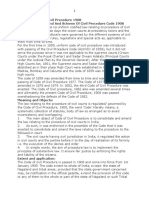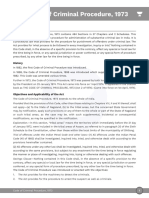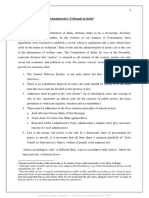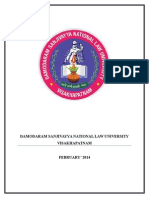0 ratings0% found this document useful (0 votes)
22 viewsUnit 1 - Code of Civil Procedure - History
class notes
Uploaded by
megha.9119marymichaelCopyright
© © All Rights Reserved
Available Formats
Download as PPTX, PDF, TXT or read online on Scribd
0 ratings0% found this document useful (0 votes)
22 viewsUnit 1 - Code of Civil Procedure - History
class notes
Uploaded by
megha.9119marymichaelCopyright
© © All Rights Reserved
Available Formats
Download as PPTX, PDF, TXT or read online on Scribd
You are on page 1/ 6
History of the code
• Before 1859, there was no uniform Code of Civil Procedure, there
were different systems of civil procedure in different parts of the
country.
• Under the British rule, there were Crown Courts in Presidency towns
(Madras, Bombay and Calcutta) and Provincial Courts in Mofussils.
• The first uniform Code of Civil Procedure was enacted in 1859 , but
this Code was also not made applicable to the Supreme Courts in the
Presidency Towns and to the Presidency Small Cause Courts.
• Some amendments were made therein and the Code was applied to
the whole of British India, but there were many defects in it, and
therefore, a new Code was enacted in 1877. Again, another Code
was enacted in 1882, which was also amended from time to time.
In 1908, the present Code of Civil Procedure was enacted.
The Law Commission in its various reports made many recommendations,
and after carefully considering them, the Government decided to bring
forward the Bill for the amendment of the Code of Civil Procedure, 1908,
keeping in view, inter alia, the following considerations:
a litigant should get a fair trial in accordance with the accepted
principles of natural justice;
every effort should be made to expedite the disposal of civil suits
and proceedings, so that justice may not be delayed;
the procedure should not be complicated, and should, to the
utmost extent possible, ensure a fair deal to the poorer sections of
the community who do not have the means to engage a pleader to
defend their cases.
It was amended by two important Amendment Acts of 1951 and
1956.
Meaning and Object of the Code:
• The Law relating to the practices and procedure to be
followed in the Civil Courts is regulated by the Code of Civil
Procedure, 1908.
• The Aim of the Procedural law is to implement the principles
of Substantive law. This Code ensures fair justice by
enforcing the rights and liabilities.
• Civil Procedure Code provides the mechanism for
enforcement of rights and liabilities.
• The Civil Procedure Code in India embodies a mixture of strictness
of procedure and of discretionary powers vested in the courts. The
aim is to do justice.
• The Code of Civil Procedure, 1908 is concerned almost wholly with
institution of a suit in a civil court, the progress of its trial ending
with orders or a decree and its further stages such as appeals,
reference, reviews and revision and the execution of decrees and
orders.
Supreme Court of India in Sangram Singh v. Election Tribunal, AIR
1955 SC 425, Bose J. said: …..It is a "procedure" something
designated to facilitate justice and further its ends, not a penal
enactment for punishment and penalties, not a thing design to trip
people up.
The Civil Procedure Code is a general law and will not affect local or
special laws (applicable to a particular subject) which are already in
force. In case of any conflict with local or special laws, the local or
special law will prevail over the Civil Procedure Code. In case, if the
local or special law is silent about any particular issue, then the Civil
Procedure Code will apply.
Object of the Code: The object of the Code is to consolidate and
amend the laws relating to the procedure of Courts of Civil Judicature.
It is a consolidated Code collecting all the laws relating to the
procedure to be adopted by civil courts.
The provisions of the Code have evolved as a matter of long years of
experience emanating out of the common law of England. (Subrata Roy
Sahara v. Union of India, (2014) 8 SCC 470)
As observed in Prem Lala Nahata v. Chandi Prasad Sikaria, 2007 2
SCC 551, the Code consolidates and amends the laws relating to the
procedure of the Courts of Civil Judicature. No doubt it also deals
with certain substantive rights, but its essential object is to
consolidate the law relating to civil procedure.
In Saiyad Mohd. Bakar v. Abdulhabib Hasan, 1998, 4 SCC 343,
Supreme Court stated, “A procedural law is always in aid of justice,
not in contradiction or to defeat the very object which is sought to be
achieved. A procedural law is always subservient (subordinate) to the
substantive law. Nothing can be given by a procedural law what is
not sought to be given by a substantive law and nothing can be taken
away by the procedural law what is given by the substantive law.”
You might also like
- Constitutional Law - Answers To Previous Question PapersNo ratings yetConstitutional Law - Answers To Previous Question Papers67 pages
- Civil Procedure Code Made Simple For BeginnersNo ratings yetCivil Procedure Code Made Simple For Beginners77 pages
- P_S_JAIN'S_CIVIL_PROCEDURE_CODE_CPC_1ST_UNIT_KSLU_1No ratings yetP_S_JAIN'S_CIVIL_PROCEDURE_CODE_CPC_1ST_UNIT_KSLU_124 pages
- 1c P C & Limitation Act - 2019-20 Rs.185No ratings yet1c P C & Limitation Act - 2019-20 Rs.185268 pages
- Nature of CPC, 1908: Arranged As To Avoid Inconsistency and OverlappingNo ratings yetNature of CPC, 1908: Arranged As To Avoid Inconsistency and Overlapping7 pages
- CPC UNIT-I - STUDY MATERIAL_ CHETNA ANJUMNo ratings yetCPC UNIT-I - STUDY MATERIAL_ CHETNA ANJUM117 pages
- Alternative Dispute Resolution Module-2No ratings yetAlternative Dispute Resolution Module-211 pages
- Relations Between Union and The States in India29% (7)Relations Between Union and The States in India20 pages
- Substantive and Procedural Law: Code of Civil Procedure and Limitation Act Unit 1No ratings yetSubstantive and Procedural Law: Code of Civil Procedure and Limitation Act Unit 183 pages
- Justice Mr. V. G. Palshikar (Retd.) : Judicial Activism100% (1)Justice Mr. V. G. Palshikar (Retd.) : Judicial Activism11 pages
- Jurisprudential Analysis of Code of Civil Procedure, 1908100% (1)Jurisprudential Analysis of Code of Civil Procedure, 190818 pages
- Indian Legal System - Structure and Features100% (2)Indian Legal System - Structure and Features27 pages
- History, Meaning and Concept: Civil Procedure Code-INo ratings yetHistory, Meaning and Concept: Civil Procedure Code-I9 pages
- Civil Procedure Code, 1908, Ll.B. Part Iii TOPIC: An Introduction To CPC, 26 of Sep, 2016No ratings yetCivil Procedure Code, 1908, Ll.B. Part Iii TOPIC: An Introduction To CPC, 26 of Sep, 20163 pages
- Mod Iii-Legislative Framework and Recent Developments100% (1)Mod Iii-Legislative Framework and Recent Developments10 pages
- Civil Procedure Code and Limitation ActNo ratings yetCivil Procedure Code and Limitation Act48 pages
- Gram Nyayalyas & Lok Adalats: SUBMITTED BY:-Purva Juneja Roll No: - 15184 B.A.LL.B (H)No ratings yetGram Nyayalyas & Lok Adalats: SUBMITTED BY:-Purva Juneja Roll No: - 15184 B.A.LL.B (H)23 pages
- Indian Economy On The Eve of Independence Chapter 1No ratings yetIndian Economy On The Eve of Independence Chapter 13 pages
- Constitution of India-5,10,20 Marks Question BankNo ratings yetConstitution of India-5,10,20 Marks Question Bank49 pages
- Effect of British Rule On Socio Economic Factors 1st ChapterNo ratings yetEffect of British Rule On Socio Economic Factors 1st Chapter14 pages
- Polygar War - (1795 - 1805) - 14221858 - 2023 - 12 - 07 - 13 - 13No ratings yetPolygar War - (1795 - 1805) - 14221858 - 2023 - 12 - 07 - 13 - 132 pages
- British Imperialism in India In-Class ActivityNo ratings yetBritish Imperialism in India In-Class Activity13 pages
- An Economic History of India 1707–1857, 2nd Edition Tirthankar Roy - The ebook is ready for download with just one simple click100% (1)An Economic History of India 1707–1857, 2nd Edition Tirthankar Roy - The ebook is ready for download with just one simple click79 pages
- AK CN Grade+5 Social+Science Chapter+13 Class+2 v02No ratings yetAK CN Grade+5 Social+Science Chapter+13 Class+2 v022 pages
- Charter Act 1813 - 14221776 - 2023 - 12 - 07 - 13 - 19No ratings yetCharter Act 1813 - 14221776 - 2023 - 12 - 07 - 13 - 193 pages
- Economic Impact of British Rule in India History Study Material NotesNo ratings yetEconomic Impact of British Rule in India History Study Material Notes3 pages
- Constitutional Set Up of East India CompanyNo ratings yetConstitutional Set Up of East India Company20 pages
- Constitutional Development Regulating Act 1773 To Charter Act 1853 56No ratings yetConstitutional Development Regulating Act 1773 To Charter Act 1853 564 pages
- Constitutional Law - Answers To Previous Question PapersConstitutional Law - Answers To Previous Question Papers
- P_S_JAIN'S_CIVIL_PROCEDURE_CODE_CPC_1ST_UNIT_KSLU_1P_S_JAIN'S_CIVIL_PROCEDURE_CODE_CPC_1ST_UNIT_KSLU_1
- Nature of CPC, 1908: Arranged As To Avoid Inconsistency and OverlappingNature of CPC, 1908: Arranged As To Avoid Inconsistency and Overlapping
- Substantive and Procedural Law: Code of Civil Procedure and Limitation Act Unit 1Substantive and Procedural Law: Code of Civil Procedure and Limitation Act Unit 1
- Justice Mr. V. G. Palshikar (Retd.) : Judicial ActivismJustice Mr. V. G. Palshikar (Retd.) : Judicial Activism
- Jurisprudential Analysis of Code of Civil Procedure, 1908Jurisprudential Analysis of Code of Civil Procedure, 1908
- History, Meaning and Concept: Civil Procedure Code-IHistory, Meaning and Concept: Civil Procedure Code-I
- Civil Procedure Code, 1908, Ll.B. Part Iii TOPIC: An Introduction To CPC, 26 of Sep, 2016Civil Procedure Code, 1908, Ll.B. Part Iii TOPIC: An Introduction To CPC, 26 of Sep, 2016
- Mod Iii-Legislative Framework and Recent DevelopmentsMod Iii-Legislative Framework and Recent Developments
- Gram Nyayalyas & Lok Adalats: SUBMITTED BY:-Purva Juneja Roll No: - 15184 B.A.LL.B (H)Gram Nyayalyas & Lok Adalats: SUBMITTED BY:-Purva Juneja Roll No: - 15184 B.A.LL.B (H)
- Indian Economy On The Eve of Independence Chapter 1Indian Economy On The Eve of Independence Chapter 1
- Effect of British Rule On Socio Economic Factors 1st ChapterEffect of British Rule On Socio Economic Factors 1st Chapter
- Polygar War - (1795 - 1805) - 14221858 - 2023 - 12 - 07 - 13 - 13Polygar War - (1795 - 1805) - 14221858 - 2023 - 12 - 07 - 13 - 13
- An Economic History of India 1707–1857, 2nd Edition Tirthankar Roy - The ebook is ready for download with just one simple clickAn Economic History of India 1707–1857, 2nd Edition Tirthankar Roy - The ebook is ready for download with just one simple click
- AK CN Grade+5 Social+Science Chapter+13 Class+2 v02AK CN Grade+5 Social+Science Chapter+13 Class+2 v02
- Charter Act 1813 - 14221776 - 2023 - 12 - 07 - 13 - 19Charter Act 1813 - 14221776 - 2023 - 12 - 07 - 13 - 19
- Economic Impact of British Rule in India History Study Material NotesEconomic Impact of British Rule in India History Study Material Notes
- Constitutional Development Regulating Act 1773 To Charter Act 1853 56Constitutional Development Regulating Act 1773 To Charter Act 1853 56
























































































